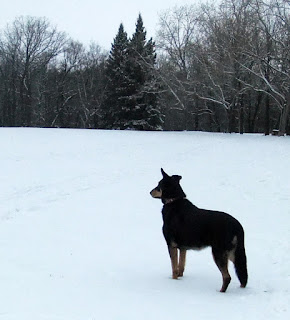Let's get down to feet
The purpose of this post is to help you learn to take care of your dog's feet.
If you don't take care of your dogs feet, the pads will crack and split. Causing your dog pain. If your dog enjoys skijoring, it is very likely they will work through any pain, and just keep going. It is the job of the skijorer to check and maintain the dog's feet.
Before we leave the house, and after every run, I check their feet, to make sure there are no cracks in the pads.
Before we leave the house, and after every run, I check their feet, to make sure there are no cracks in the pads.
Start in the Fall
Starting in the fall, we build up the dogs foot pads, by long walks, on a variety of surfaces. I say walks, cause a dog can easily blow a pad on a run, on the wrong surface.
Assuming you have built up your dogs feet starting in the fall, ensure you are feeding zinc in your dog's diet, you can this by adding fish oils or peanut butter to your dogs diet to help toughen up the pads.
Musher's Secret
 |
The Oxford Dogs use Musher's Secret. It softens the pads, prevents cracking, and also stops ice balls from building up around the toes. It is a wax product, and if the dog eats some, it's not going to do them any harm. Depending on how long you are out for, and the snow conditions, you might have to reapply the wax. We wax up right before we hit the trail, in the truck.
If the dogs have small cracks in their pads, they are off running until the cracks heal, and we treat the pads with Musher's Secret once a day until the pads are in good shape again.
Hair Care
 When you are running your dog in the winter, ensure there is no hair growth between the pads. Keep the hair short with a pair of scissors, or clippers. If your dog is not happy with you touching his feet, or you are worried about doing the trimming, take them into a groomer. It's worth it, rather than cutting the webbing or slicing their foot by accident.
When you are running your dog in the winter, ensure there is no hair growth between the pads. Keep the hair short with a pair of scissors, or clippers. If your dog is not happy with you touching his feet, or you are worried about doing the trimming, take them into a groomer. It's worth it, rather than cutting the webbing or slicing their foot by accident.
If there hair between the toes is allowed to grow too long, ice balls will form between the toes, spreading them apart. Which will not only distract your dog from pulling, but will make mushing unpleasant.
The Dangers of Pavement
Running a hard running dog, or a fresh dog on hard surfaces like pavement, sidewalks, roads, even sand after a rain will lead to wearing od the dogs pads faster than running on softer surfaces, like dirt pack trails, or a good base of snow.
If you choose to run your dog on such surfaces, you are running the risk of wearing right through their pads. Look for shiny spots on the pads, or spots that look like drops of moisture. This means you have blown through all the layers of skin, and are down to about one layer left. Stop now! If you have been running your dog on pavemenet, you may also see small red, or black holes in the pad. These are holes from where the pad has been worn or ripped off by the hard surface.
Don't run your dog on pavement.



